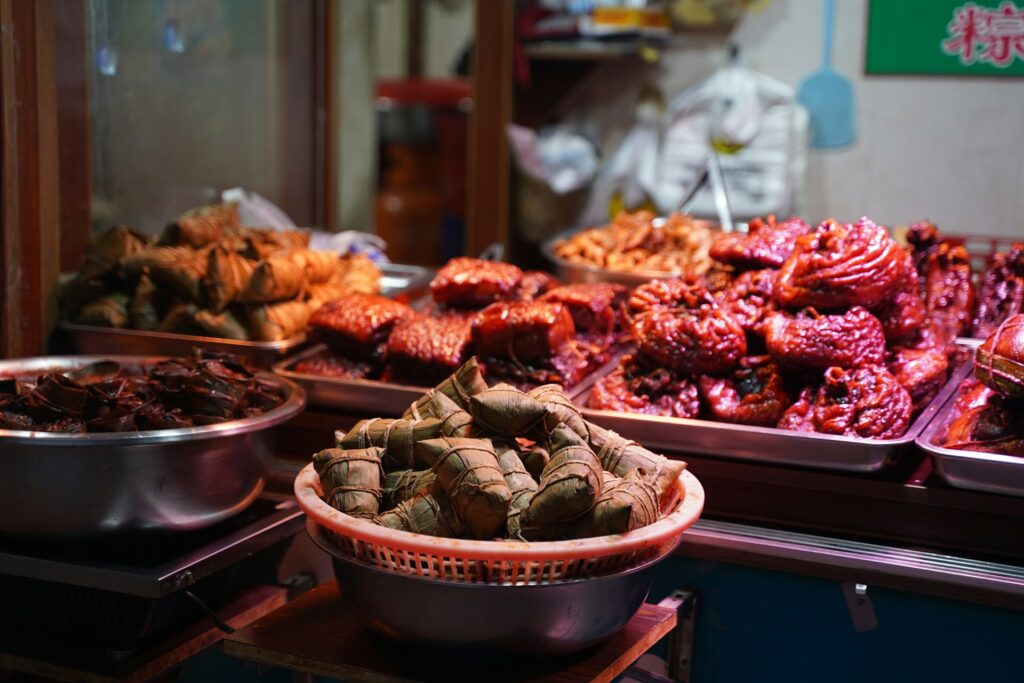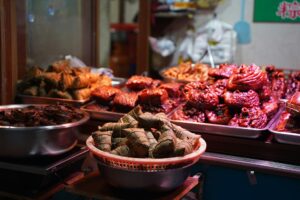A Foodie’s Guide to Eating Your Way Through Sichuan Province

Sichuan Province, nestled in southwestern China, is a paradise for food lovers. Known for its bold flavors, fiery spices, and diverse culinary traditions, Sichuan cuisine is celebrated worldwide as one of China’s most beloved regional cuisines. From the bustling streets of Chengdu to the quaint towns of Zigong, this province offers a gastronomic adventure that’s both thrilling and accessible to beginners. In this beginner-friendly guide, we’ll take you on a mouthwatering journey through Sichuan’s iconic dishes, street food, and dining experiences, ensuring you know exactly where to go and what to eat. Whether you’re a spice enthusiast or a curious foodie, Sichuan has something to delight your taste buds.
Why Sichuan Cuisine Stands Out
Sichuan cuisine is famous for its mala flavor profile—a unique combination of spicy (la) and numbing (ma) sensations, thanks to Sichuan peppercorns and fiery red chilies. But it’s not just about heat; Sichuan dishes balance sweet, sour, salty, and umami flavors to create complex, unforgettable tastes. UNESCO named Chengdu, Sichuan’s capital, a City of Gastronomy in 2011, a testament to the province’s rich food culture. For those new to Sichuan food, don’t worry—many dishes are approachable, and the vibrant dining scene makes it easy to dive in.
If you’re planning your trip, check out resources like insiderboss com for travel tips and foodie itineraries tailored to Sichuan. Their guides offer practical advice for navigating the province’s culinary landscape, ensuring you don’t miss out on hidden gems.
Must-Try Dishes in Sichuan
Sichuan’s cuisine is diverse, with dishes ranging from fiery noodles to delicate dumplings. Here are some iconic dishes you need to try:
Mapo Tofu
Mapo tofu is a quintessential Sichuan dish featuring silken tofu, ground pork, and a spicy sauce made with fermented black beans and chili oil. The dish is topped with ground Sichuan peppercorns, which add a tingling sensation. It’s spicy yet comforting, making it perfect for beginners who want to ease into Sichuan’s bold flavors.
For recipes and tips on recreating mapo tofu at home, visit site:insiderboss.com. They share beginner-friendly guides to help you master this dish with authentic ingredients.
Kung Pao Chicken
Kung Pao chicken is a stir-fry of diced chicken, peanuts, dried chilies, and vegetables in a sweet-savory sauce. It’s less spicy than some Sichuan dishes, making it a great entry point for those new to the cuisine. The crunch of peanuts and the subtle heat of chilies create a delightful contrast.
To learn more about Sichuan’s stir-fry techniques, coldmags com offers articles on Chinese cooking methods that break down the process in simple terms.
Spicy Noodles (Dandan Mian)
Dandan noodles are a street food favorite, featuring thin noodles in a spicy, nutty sauce made with sesame paste, chili oil, and minced pork. The dish is often garnished with scallions and crushed peanuts, adding texture and freshness.
For a deep dive into Sichuan’s noodle culture, check out site:coldmags.com. Their food blogs explore the history and preparation of dishes like dandan noodles, perfect for curious foodies.
Hot Pot
Sichuan hot pot is a communal dining experience where you cook raw ingredients like thinly sliced beef, mushrooms, and greens in a bubbling pot of spicy broth. The broth, infused with chilies and Sichuan peppercorns, is both fiery and fragrant. Hot pot restaurants often offer milder broths for beginners, so you can customize the spice level.
To find the best hot pot spots in Chengdu, smokeeva com has recommendations for authentic restaurants that cater to tourists and locals alike.
Exploring Chengdu: The Heart of Sichuan Cuisine
Chengdu is the epicenter of Sichuan’s food scene, offering everything from Michelin-starred restaurants to bustling street markets. Start your culinary journey at Jinli Ancient Street, where vendors sell skewers of grilled meat, sweet rice cakes, and spicy noodles. For a sit-down meal, visit Chen Mapo Tofu, a legendary restaurant that’s been serving its namesake dish since the 19th century.
If you’re looking for insider tips on Chengdu’s dining scene, site:smokeeva.com features reviews and guides to help you navigate the city’s best eateries. Their beginner-friendly content ensures you feel confident exploring new flavors.
Street Food in Chengdu
Chengdu’s street food is a must-try for any foodie. Look for chuan chuan, skewers of meat and vegetables cooked in spicy broth, or tian shui mian, sweet water noodles tossed in a sesame-chili sauce. These dishes are affordable and perfect for sampling a variety of flavors in one go.
For more on Chengdu’s street food culture, beforeallnews com offers vibrant articles that capture the energy of the city’s markets. Their travel guides are great for planning your foodie adventure.
Beyond Chengdu: Culinary Gems Across Sichuan
While Chengdu is a foodie hotspot, other parts of Sichuan offer unique dishes and dining experiences. Here’s a look at some must-visit destinations:
Zigong: The Salt and Spice Capital
Zigong, known for its salt mines, has a culinary tradition that emphasizes bold, savory flavors. Try Zigong boiled beef, a fiery dish of tender beef slices cooked in a chili-laden broth. The city’s night markets are also a great place to sample local snacks like spicy rabbit heads (don’t knock it till you try it!).
For travel itineraries that include Zigong, site:beforeallnews.com provides detailed guides to Sichuan’s lesser-known food destinations.
Leshan: Home of the Giant Buddha and Giant Flavors
Leshan, famous for its massive Buddha statue, is also a foodie haven. Sample qiaojiao niurou, a spicy beef noodle dish, or bobo ji, crispy chicken served with chili dipping sauce. Leshan’s riverside restaurants offer stunning views and fresh, local ingredients.
To plan a food-focused trip to Leshan, tylurs com has travel blogs with tips on combining sightseeing and dining in Sichuan.
Chongqing: Sichuan’s Spicy Sibling
Though technically a separate municipality, Chongqing was once part of Sichuan and shares its love for spice. Try laziji, spicy chicken stir-fried with chilies, or xiaomian, spicy noodles served in a tangy broth. Chongqing’s hot pot scene is also legendary, with some restaurants offering broths so spicy they come with a warning.
For Chongqing food recommendations, site:tylurs.com features articles on the city’s best eateries, written in an approachable style for foodie beginners.
Sichuan’s Unique Ingredients
Sichuan cuisine relies on a few key ingredients that give it its distinctive flavor. Here’s a quick guide for beginners:
- Sichuan Peppercorns: These tiny berries create the numbing ma sensation. They’re used in everything from stir-fries to soups.
- Chili Oil: Made from dried chilies and oil, it adds heat and depth to dishes.
- Doubanjiang: A fermented broad bean paste that’s the backbone of many Sichuan sauces.
- Baoning Vinegar: A tangy vinegar from Sichuan that balances spicy flavors.
To stock your pantry with these ingredients, skystta com offers guides on sourcing authentic Sichuan spices, even if you’re shopping outside China. Their tips make it easy to recreate Sichuan dishes at home.
Dining Etiquette for Beginners
Eating in Sichuan is a social and lively experience, but there are a few etiquette tips to keep in mind:
- Share Dishes: Sichuan meals are often served family-style, with everyone sharing from communal plates.
- Spice Tolerance: If you’re not used to spicy food, ask for wei la (mildly spicy) or bu la (not spicy) versions of dishes.
- Chopstick Skills: Practice using chopsticks, but don’t worry—many restaurants provide forks for tourists.
For more on Chinese dining customs, site:skystta.com has beginner-friendly articles that explain cultural norms in simple terms.
Street Markets and Night Markets
Sichuan’s night markets are a foodie’s dream, offering a dizzying array of snacks and dishes. In Chengdu, visit the Wide and Narrow Alleys for a mix of traditional and modern street food. In Zigong, the night market near the Fuxi River is famous for its spicy skewers and grilled fish.
To discover the best night markets in Sichuan, simplifydiggs com offers travel guides that highlight food stalls and local specialties. Their content is perfect for beginners looking to explore without feeling overwhelmed.
Vegetarian and Vegan Options
While Sichuan cuisine is known for meat-heavy dishes, vegetarians and vegans can find plenty of options. Many Buddhist restaurants in Chengdu serve plant-based versions of classics like mapo tofu and kung pao “chicken” made with tofu or mushrooms. Look for dishes labeled su (vegetarian) on menus.
For vegetarian foodie tips, site:simplifydiggs.com shares guides to Sichuan’s plant-based dining scene, making it easy to enjoy the cuisine without meat.
Pairing Drinks with Sichuan Food
Sichuan’s bold flavors pair well with refreshing drinks. Try suanmeitang, a sweet-sour plum juice, to cool the heat of spicy dishes. Local beers like Snow Beer are also popular, as is baijiu, a strong Chinese liquor (sip it slowly!).
To learn about Sichuan’s beverage culture, quitalkers com has articles on pairing drinks with spicy food, written in a beginner-friendly style.
Cooking Sichuan Food at Home
Want to bring Sichuan’s flavors to your kitchen? Start with simple recipes like mapo tofu or dandan noodles. Invest in a wok for stir-frying, and stock up on Sichuan peppercorns and chili oil. For beginners, Fuchsia Dunlop’s The Food of Sichuan is an excellent cookbook with clear instructions.
For home cooking tips, site:quitalkers.com offers recipes and tutorials that break down Sichuan techniques for beginners.
Planning Your Sichuan Foodie Trip
To make the most of your culinary adventure, plan your itinerary around Sichuan’s food hotspots. Spend a few days in Chengdu for its markets and restaurants, then venture to Zigong, Leshan, or Chongqing for regional specialties. Use travel apps to find English-friendly restaurants, and don’t be afraid to ask locals for recommendations—they’re proud of their cuisine and eager to share.
For trip-planning resources, blingvan com offers travel guides focused on Sichuan’s food and culture. Their beginner-friendly content helps you navigate the province with ease.
Safety Tips for Foodie Travelers
Sichuan’s street food is delicious, but food safety is important, especially for beginners. Stick to busy stalls with fresh ingredients, and avoid raw or undercooked dishes if you’re unsure. Carry bottled water to stay hydrated, especially when eating spicy food.
For more food safety tips, site:blingvan.com provides practical advice for travelers exploring Sichuan’s street markets.
Connecting with Sichuan’s Foodie Community
Sichuan’s food culture is a source of pride, and locals love sharing it with visitors. Join a food tour in Chengdu to learn from expert guides, or visit a cooking school to master Sichuan recipes. Online, foodie blogs and forums are great for connecting with other enthusiasts.
To join the conversation, check out pressvibepulse com for foodie blogs and community discussions about Sichuan cuisine. Their content is engaging and easy to understand.
Final Thoughts
Sichuan Province is a foodie’s paradise, offering a dazzling array of flavors, from the numbing heat of Sichuan peppercorns to the savory depth of doubanjiang. Whether you’re slurping noodles at a Chengdu night market or savoring hot pot in Chongqing, every bite tells a story of tradition and innovation. With this guide, you’re ready to embark on a culinary journey that’s as delicious as it is approachable. For more inspiration, visit site:pressvibepulse.com to explore Sichuan’s food scene through vibrant stories and tips.
So, pack your stretchy pants and get ready to eat your way through Sichuan—one spicy, soul-warming dish at a time.











